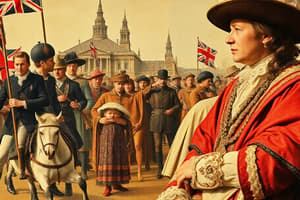Podcast
Questions and Answers
What were the Restoration colonies established by Charles II?
What were the Restoration colonies established by Charles II?
The Restoration colonies established by Charles II included New York, New Jersey, Pennsylvania, and the Carolinas.
What significant economic policy did Charles II implement to control colonial trade?
What significant economic policy did Charles II implement to control colonial trade?
Charles II enacted the mercantilist Navigation Acts to control and benefit from colonial trade.
What led to the English Civil War during Charles I's reign?
What led to the English Civil War during Charles I's reign?
The English Civil War was caused by the struggle between Charles I and Parliament over issues like taxation and religion.
What was the outcome of the English Civil War for Charles I?
What was the outcome of the English Civil War for Charles I?
Why did many English subjects turn against Oliver Cromwell's rule?
Why did many English subjects turn against Oliver Cromwell's rule?
Flashcards
Restoration of the Monarchy
Restoration of the Monarchy
The re-establishment of the English monarchy in 1660 with Charles II as king.
Charles II's Achievements
Charles II's Achievements
Expanded England's North American territories by establishing new colonies like New York and Pennsylvania.
Navigation Acts
Navigation Acts
Laws enacted by Charles II to regulate colonial trade for England's economic benefit.
English Civil War
English Civil War
Signup and view all the flashcards
Cromwell's Commonwealth
Cromwell's Commonwealth
Signup and view all the flashcards
Study Notes
Restoration of the English Monarchy
- Charles II ascended the throne in 1660, marking the restoration of the monarchy after the English Civil Wars.
- Charles II aimed to strengthen England's global power, adding territories to North America (New York, New Jersey, Pennsylvania, Carolinas)
- Mercantilist Navigation Acts were enacted to benefit from overseas possessions, but enforcement was weak.
The English Civil War and Interregnum
- Charles I's reign (1625-1649) saw escalating conflict with Parliament over taxes and religious policies.
- The English Civil War (1642-1649) pitted Royalists against Parliamentarians.
- Charles I was executed in 1649, ending the monarchy and establishing a republic under Oliver Cromwell.
- Oliver Cromwell's rule faced growing dissatisfaction, leading to the Restoration.
The Restoration Colonies
- Charles II established proprietary colonies in North America (Carolinas, New Jersey, New York, Pennsylvania).
- Proprietary colonies were granted to individuals, families, or groups.
- Charles II aimed to control the area between Virginia and Spanish Florida.
- The Carolina colony was initially established by plantation owners from Barbados using enslaved labor, creating Charles Town (Charleston).
Slavery in the Carolinas
- Slavery was crucial to the development of the Southern Carolina economy, particularly rice plantations.
- A wealthy planter class emerged.
- The legal framework for slavery mirrored the Barbados slave codes.
Native American Relations
- Native Americans in the Carolinas faced the introduction of European diseases and displacement.
- Trade with Native Americans involved exchange of goods (deer skins).
The Yamasee War (1715-1718)
- Rivalry over land and trade with Native Americans (Yamasee and Creek) led to the conflict.
- The coalition of tribes nearly succeeded in driving the English out.
New York Colony
- The English acquired New Netherland (New York) from the Dutch during the Anglo-Dutch Wars.
- New York was renamed by the Duke of York.
- A local representative legislature convened.
- Established the Charter of Liberties and Privileges, reflecting traditional English rights.
- Continued the Dutch patroonship system granting large estates.
Pennsylvania Colony
- Pennsylvania was established in 1681 and granted to William Penn to extinguish a debt.
- William Penn was a Quaker, emphasizing religious tolerance
- Pennsylvania attracted Quakers and other religious groups, becoming known for religious freedom (except Massachusetts).
- Pennsylvania established peaceful relations with local tribes, including the Lenni Lenape (Delaware).
- Quakers adopted pacifism.
Colonial Life in Early Philadelphia
- Philadelphia flourished as a port city.
- Colonial life involved immigration, both from Europe and as indentured servants.
- The American Weekly Mercury reveals the presence of enslaved people and issues related to runaways.
Mercantilism and the Navigation Acts
- England sought better control over trade with American colonies.
- The Navigation Acts were mercantilist policies intended to maximize England's benefit from colonial trade.
- Specific goods (sugar, tobacco, indigo, rice, molasses, naval stores) were designated for trade with England or other British colonies.
- Salutary neglect characterized British policy of lax enforcement of navigation acts.
Molasses Act of 1733
- This act aimed to favor British West Indian producers, imposing duty on sugar, rum, and molasses from competitors.
- However, New Englanders frequently engaged in smuggling.
Studying That Suits You
Use AI to generate personalized quizzes and flashcards to suit your learning preferences.




